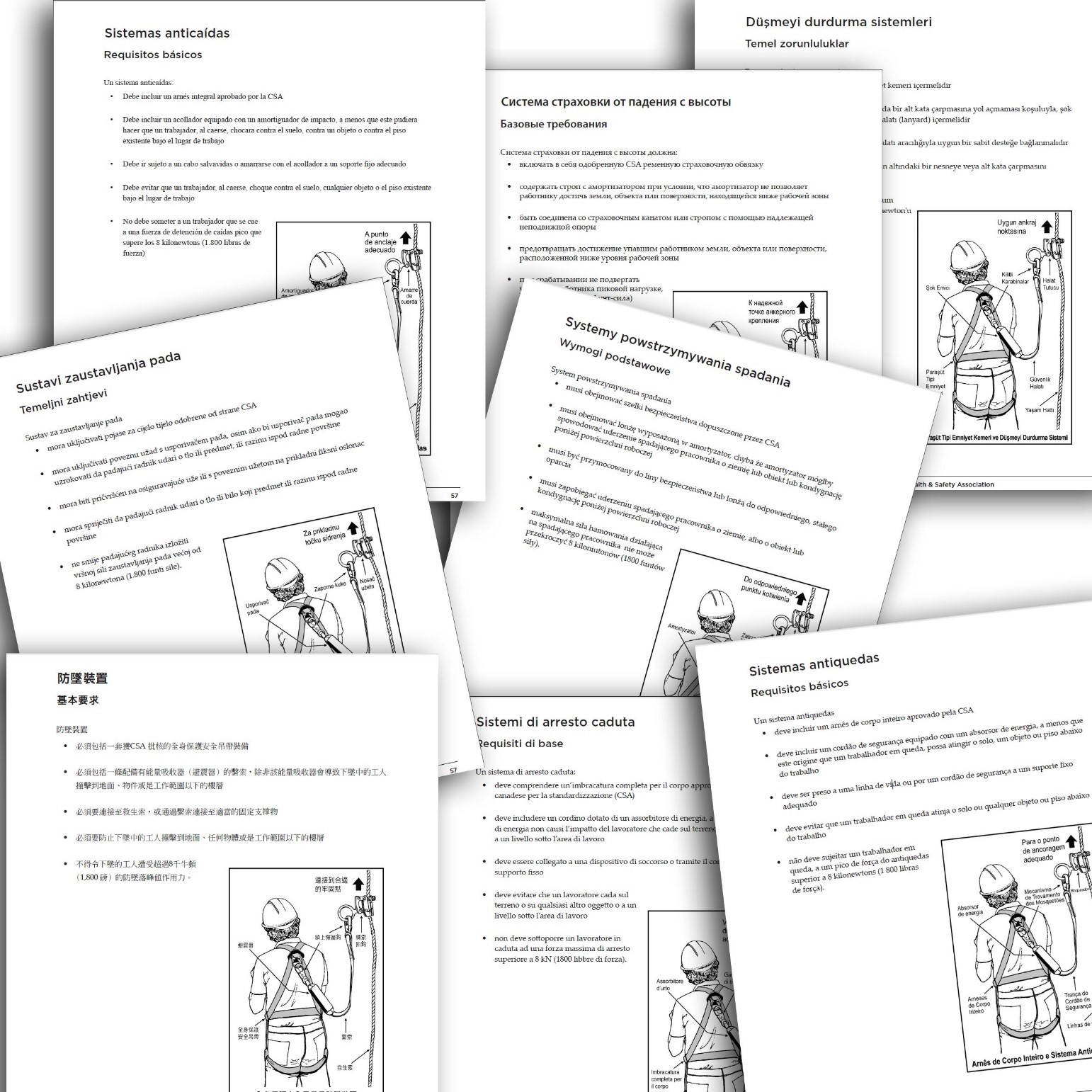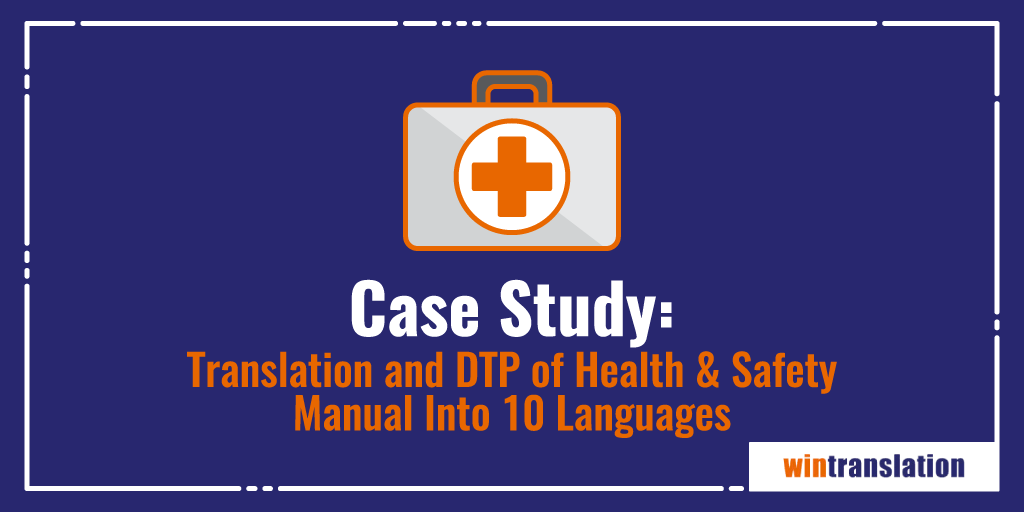Case Study: Translation and DTP of Health & Safety Manual Into 10 Languages
BACKGROUND
Recent changes in provincial legislation made it a requirement for all employees whose jobs involve working at heights to obtain accredited training. Our client, the IHSA (Infrastructure Health & Safety Association) is a leader in health and safety education, and through skills-based training, auditing, and evaluation, they provide safety solutions to those who perform high-risk activities, including working at heights.
Being one of the major providers of this (now mandatory) accredited training, IHSA decided to have their manuals translated into various languages in order to reach a wider audience. wintranslation won the contract to work as IHSA’s translation services provider.
The materials requiring translation were training manuals and documents intended for those working at heights in the fields of: construction, tower repair, building/window maintenance, and roofing amongst others. wintranslation was tasked with translating a 142-page manual into 10 languages, with a total of over 310,000 words to be translated into:
- Chinese (Simplified)
- Chinese (Traditional-Cantonese/Hong Kong dialect)
- Croatian
- Italian
- Polish
- Portuguese (European)
- Russian
- Serbian (Cyrillic script)
- Spanish (European)
- Turkish
THE CHALLENGES
Maintaining Accuracy with Industry-Specific Terminology
While the material involved with this project was relatively straightforward and easy-to-understand, there were also industry-specific technical terms and concepts that required special treatment. The challenge was to ensure that the integrity of the terminology was preserved, while fully translating the meaning into each respective language. Our team worked to ensure that our translators understood what these industry-specific terms meant to the full extent before they started translating them.
Maintaining Consistency across Various Languages
wintranslation had to ensure that consistency was maintained across all files and languages. This is no small feat for over 300,000 words and 10 languages! We had to ensure that all the translators were using the same level and style of language, and that all were able to fully utilize the proper translation tools.
Quick Turn-Around Last-Minute Additions
Another challenge arose during the project when additional words for translation were added. Our project managers worked with our translators and revisers to ensure that everything was completed on time despite the unexpected increase in word-count. Small changes and last-minute edits were done in-house to ensure that the final product was delivered on time with the highest of quality

click here to see this sample page in all 10 languages
OUR SOLUTIONS
Translator Selection
A crucial part of the process was translator section. We made sure to recruit translators who had experience in the health and safety industries and felt confident dealing with industry terminology. We also made sure the revisers selected for the project had experience in the field.
Terminology Management
An important part of all our translation projects is terminology management. Before starting the project, using term extraction tools (memoQ) one of our terminologists went through the English manuals and extracted all industry-specific terms and acronyms which may need further explanation or background. Once the extraction was completed, the terms and their definitions were compiled to create a multilingual term base. This term base was created for each language and shared with all translators and revisers involved in the project. The terminology database will be updated and maintained for the client for any future projects.
Multi-Step Process
Step One: Translation: To assure that the final product was of the highest quality, we used our standard multi-step process to ensure that the translations were accurate and that nothing was missed. Step one started with the client sending us the original files in InDesign. Since translators can’t work in InDesign, our project managers prepared the files for translation in Trados Studio. Packages including files for translation, terminology, reference materials and style guides were send to translators.
Step Two: Editing: After the translations were completed, the second step was to send the translated files to our revisers to edit and verify that everything was correct.
Step Three: QA: Once the translated material passed the editing step, our project managers took the files and did a Quality Assurance (QA) verification in Trados Studio. This was to ensure that there were no tag-related or other errors introduced during translation and editing and also to verify that all terminology used was consistent throughout.
Step Four: DTP: Once verified, the files were then exported back to the original format (InDesign). However, at this point, the files are in a “raw” format and required some extra formatting in order to preserve the initial layout. This was due to the fact that some languages take up more space than the others, some require special fonts, different style definitions and sometimes even different InDesign versions.
The InDesign files also had many images with text inside them, which were un-editable and therefore had to be recreated in Photoshop by our DTP professionals. To reduce the time spent on image recreation, wintranslation’s DTP specialists set up an automated process in Photoshop, saving time and money for our client.
Step Five: Final Revision: After the DTP step, the files were saved as low resolution PDFs and send to editors again for a quick, final revision. This is an important step which allows editors to see the text and images in the final format—the same format which the end users—in order to make final changes if necessary.
BENEFITS OF OUR PROCESS
Our process of careful translator selection, terminology management, and utilization of appropriate tools provided many benefits to the project and our client, including:
- Ensuring term consistency throughout the complete translation process by combing through the term base at the outset. The term base acted as an additional QA step to verify that the terms were translated correctly.
- Saving time by using translation tools and efficient methods to localize images.
- Cost savings by using translation memory tools to leverage translation.
- Creating a translation memory for any future projects. This will allow us to save time, money and also maintain consistency in the future.
- Reducing file management by having everything available in one package.
- Using a multi-step process to ensure the highest quality translation and DTP services.
This Post Has One Comment
Leave a Reply
You must be logged in to post a comment.



[good]